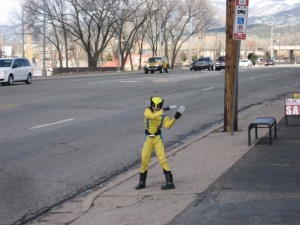 Even though Halloween was still a full moon away, London was shielded in a blue rubber breastplate highlighting the recognizable S and a faux six-pack unfolding like fancy drapery beneath. Since the Velcro had been torn away after too many tall leaps over a single couch, his cape was attached with black electrical tape. We were all watching The Amazing Race, a show that may be a race but, in London’s eyes, is not as amazing as other more heroic pursuits.
Even though Halloween was still a full moon away, London was shielded in a blue rubber breastplate highlighting the recognizable S and a faux six-pack unfolding like fancy drapery beneath. Since the Velcro had been torn away after too many tall leaps over a single couch, his cape was attached with black electrical tape. We were all watching The Amazing Race, a show that may be a race but, in London’s eyes, is not as amazing as other more heroic pursuits.
“Dad, are the people on this show real?” he asked.
“Um, yes?” I said, not wanting to explain how a camera in one’s face can alter a person or how a savvy editor can shape the course of a human life in a single episode. We were, after all, enjoying a quietly super evening at home.
“So,” he continued, “they’re just like us?”
“Sort of.” I glanced at a few model duos with midsections as sculpted as London’s costume.
“Dad, why can’t Batman be real?” he asked as soberly as Superman trying to decide which was the morally correct decision: halt a Tsunami in Southeast Asia or blow out a wildfire threatening to consume Los Angeles.
I understood his question. Since he viewed them through the same (albeit outdated) television, why couldn’t the Super Friends be as real as contestants who won new Buicks for merely stepping on a mat? Didn’t Batman deserve to be more alive than supposed ordinary Joes with names like Reichen or Chip?
When I was a boy, I wasn’t as super hero crazy as London is and rarely dressed the part unless you count flared cuffs and stained turtlenecks as costumes. Since we lived near the Atlantic until I was 10, I desperately wanted to be Aquaman. Who wouldn’t want to breathe underwater, have super strength, and communicate telepathically with sea creatures even if you ate them on church-mandated meat-free Fridays? Now that I think about it, my fascination with the hero from Atlantis may have stemmed from a near-drowning episode I had slipping on a clam and falling off a dock while fishing. Aquaman wouldn’t have needed his best friend’s father to yank him from the drink like a wet cat.
London’s love of superheroes has grown to mythic proportions from the Man of Steel and the Caped Crusader to Spidey, the Thing, Aztec, Wave Rider, Flash and the most puzzling of all, Captain America. We recently rented a video of the 1960s television series whose crude animation is the equivalent to holding up a comic book while experiencing tremors. There was so much for an aficionado like London not to love—still frames, cheesy dialogue, undefined Nazis, and a lame sidekick named Bucky who unexplainably develops the same powers as the Captain himself without chugging any secret super soldier formula. And of all the powers a person could have—flight, x-ray vision, fish-manipulation—Steve Rogers gets stuck with an indestructible shield. I expected London to yawn and ask me to use my mortal finger to switch the damn thing off, yet the boy wonder loved it. He rooted for Captain America (and awkward little Bucky); booed the Red Skull and his fascist tendencies but most of all, he fell in love with the theme song: When Captain America throws his mighty shield! Even though it was still balmy, he did his best to cobble together an outfit meant to resemble the patriotic (read: garish) ensemble Captain America wears. London grabbed some navy pants and slipped into a powder blue coat made more for cool weather than fighting Hitler’s hooligans. On his head he slapped a hat and grabbed a shield from a more medieval time period and flung it across the room. London sang the first line to the theme song, his voice full of the kind of vigor needed to win any race held inside a living room. And, after all, watching that piece of plastic hover briefly before hitting the chair was real enough for us both.
